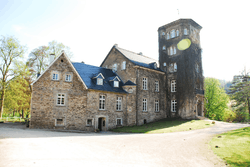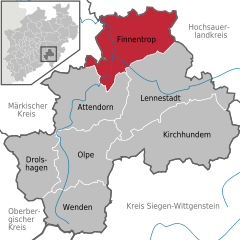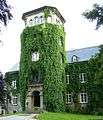Finnentrop
Finnentrop is a Gemeinde (municipality) in Olpe district in North Rhine-Westphalia, Germany.
Finnentrop | |
|---|---|
 Bamenohl castle | |
 Coat of arms | |
Location of Finnentrop within Olpe district   | |
 Finnentrop  Finnentrop | |
| Coordinates: 51°10′N 07°58′E | |
| Country | Germany |
| State | North Rhine-Westphalia |
| Admin. region | Arnsberg |
| District | Olpe |
| Subdivisions | 40 |
| Government | |
| • Mayor | Dietmar Heß (CDU) |
| Area | |
| • Total | 104.34 km2 (40.29 sq mi) |
| Highest elevation | 651 m (2,136 ft) |
| Lowest elevation | 220 m (720 ft) |
| Population (2018-12-31)[1] | |
| • Total | 17,173 |
| • Density | 160/km2 (430/sq mi) |
| Time zone | CET/CEST (UTC+1/+2) |
| Postal codes | 57413 |
| Dialling codes | 02721, 02395, 02724 |
| Vehicle registration | OE |
| Website | www.finnentrop.de |
Geography
Finnentrop is situated in the Sauerland, near the forks of the rivers Bigge and Lenne. Finnentrop shares borders with Sundern and Eslohe (both part of Hochsauerland district), Lennestadt and Attendorn (both in Olpe district), as well as with Plettenberg (Märkischer Kreis district). Finnentrop is divided into the following constituent communities:
|
|
|
History
While the municipality of Finnentrop didn't come into being before 1 July 1969, the history of the constituting villages dates back from the Middle Ages. In 1162 Lenhausen and Rönkhausen were mentioned for the first time. Until 13 July 1908, the place now known as Finnentrop had three names: Habbecke, Neubrücke (“Newbridge”) and, once the Ruhr-Sieg railway was built, Bahnhof Finnentrop (“Finnentrop Railway Station”). Neubrücke consisted of only one building at the forks of Bigge and Lenne (Reuters Haus, first mentioned in 1847). The “new bridge” seems to have already been built by 1847, as the “Reuter” had to charge tolls.
The new municipality was cobbled together in 1969 from parts of the old Amt of Serkenrode (Meschede district), the communities of Schliprüthen and Oedingen and parts of Attendorn-Land and Helden. This restructuring also saw the municipality pass from Meschede district (which was abolished in 1974) to Olpe district. The municipality’s name is drawn from the original centre of Finnentrop situated a few hundred metres up the Bigge river, now known as Altfinnentrop (“alt” is German for “old”). The ending —trop comes from trop or torp, meaning “village”. The High German word Dorf is a cognate, as is the English word thorpe.
The municipal arms shows a rose under a wavy chevron. The rose stands for the Lords of Finnentrop (von Vinnentrop) and dates back to the year 1358. The chevron stands for the two rivers, the Bigge and the Lenne, which merge in the municipality. The colour green refers to the great swathes of greenery in the municipal area.
Finnentrop maintains partnership arrangements with:
.svg.png)

Mayors
The mayor is since 1997 the jurist Dietmar Heß (* 1955) (CDU).
Culture and sightseeing
Theatres & Museums
- Schützenhof Lichtspiele, 1954-vintage movie theater renovated in 2006 with 170 seats
- Heimatstube Schönholthausen (museum)
Buildings
 St. Georg in Schliprüthen
St. Georg in Schliprüthen Mariä Himmelfahrt in Schönholthausen
Mariä Himmelfahrt in Schönholthausen Matthiaskapelle in Altfinnentrop
Matthiaskapelle in Altfinnentrop Haus Bamenohl
Haus Bamenohl Schloss Ahausen
Schloss Ahausen.jpg) Schloss Lenhausen
Schloss Lenhausen
- St. Georg hall church in (Schliprüthen), dating from before the 12th century
- Romanesque Catholic parish church Mariä Himmelfahrt in Schönholthausen, dating in parts from the 13th century
- Matthiaskapelle chapel in Altfinnentrop from 1383
- Haus Bamenohl castle in Bamenohl (14th century)
- Schloss Ahausen castle close to Heggen
- Schloss Lenhausen castle in Lenhausen (13th century)
- Reiterstellwerk (historic signal box)
Regular events
- Schützenfest (marksmen's festival) in the larger villages
- Prunksitzung by the Lenhausen Carnival Club (LCC) (revue, Saturday before Altweibertag – Old Women’s Day)
- Prunksitzung by the Festkommitee Finnentroper Karneval (revue)
- Waldfest “Im Schee” Finnentrop (“forest festival”, weekend before Whitsun)
- Spritzenfest of the fire station Bamenohl (second weekend in August)
- Open-air concert at Haus Bamenohl (third weekend in August)
- Bürgerfrühschoppen of the fire brigade on German Unity Day
- Christmas market at the town hall (second weekend in Advent)
Economy and infrastructure
Among the nationally known companies in Finnentrop are Eibach Federn (automotive springs), Metten Fleischwaren (meat processing) and a plant of ThyssenKrupp Steel Europe AG.
Transport
Finnentrop station is situated at the Ruhr–Sieg railway, from where the Bigge Valley Railway connects to Olpe. The Attendorn-Finnentrop aerodrome (ICAO airport code: EDKU) is situated close to the village of Heggen.
Public institutions
- Rathaus Finnentrop (town hall)
- Erlebnisbad Finto (natatorium)
- Jugendherberge Bamenohl (Germany’s first private youth hostel after the Second World War)
- Jugendherberge Heggen (hostel
- Finnentrop volunteer fire brigade with eleven fire stations
Education
There are six primary schools, one Hauptschule, one Realschule and one Gesamtschule.
Famous people
Honorary citizens
- Erwin Oberkalkofen, former mayor
- Ernst Vollmer, former municipality director
Sons and daughters of the municipality
- Gertrud von Plettenberg († 1608), Mistress of Ernest of Bavaria, Prince-elector-archbishop of the Archbishopric of Cologne
- Friedrich Georg Pape (1763−1816), one of the first German democrats
- Johann Joseph Freidhoff (1768−1818), engraver
- Alexander Haindorf (1784–1862), doctor, Jewish reformer, psychologist, university lecturer
- Eduard Bartling (1845−1927), entrepreneur and politician
- Lawrence Becker (1869–1947), lawyer and judge who served as Solicitor of the United States Treasury
- Henry M. Arens (1873−1963), original name Heinrich Martin Arens, politician who served in many offices in Minnesota, including the U.S. House of Representatives
- Josef Baumhoff (1887−1962), German official, newspaper publisher and politician
- Kilian Kirchhoff (1892–1944), priest, translator and dissident
- Erich Feldmann (1929−1998), Priester, Kirchenhistoriker und Augustinusforscher
- Klaus-Dieter Uelhoff (born 1936), politician, member of the Bundestag
- Reinhard Wilhelm (born 1946), scientist
- Paul Scheermann (born 1949), soccer player
- Hilde Mattheis (born 1954), politician, member of the Bundestag
Famous people who have worked in the municipality
- John A. Roebling (1806−1869), original name Johann August Röbling, civil engineer, designer of the Brooklyn Bridge
- Johannes Dornseiffer (1837−1914), priest, co-founder of many savings and loan companies connected with Friedrich Wilhelm Raiffeisen
- Hermann Hagedorn, (1884–1951), German writer, lyric poet and teacher
- Angela Maria Autsch (1900−1944), nun of the Trinitarian Order, died in the Auschwitz concentration camp
Further reading
- Bitter, Franz, Finnentrop Sauerland. Das Pfarrdorf, seine Industrie, der Eisenbahnknotenpunkt und seine Bewohner. Finnentrop 1955. edited by Sasse, R., 2005.
- Feldmann, Thomas, Die Finnentroper Chronik. Finnentrop 1994.
- Pickert’sche Sammlung, written by Voss, W., edited by Sasse, R., 2005,
- further collection of literature from the Arbeitskreis für Geschichte und Heimatpflege in der Gemeinde Finnentrop e.V.
References
- "Bevölkerung der Gemeinden Nordrhein-Westfalens am 31. Dezember 2018" (in German). Landesbetrieb Information und Technik NRW. Retrieved 10 July 2019.